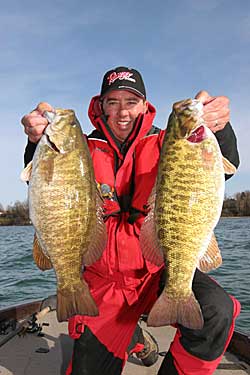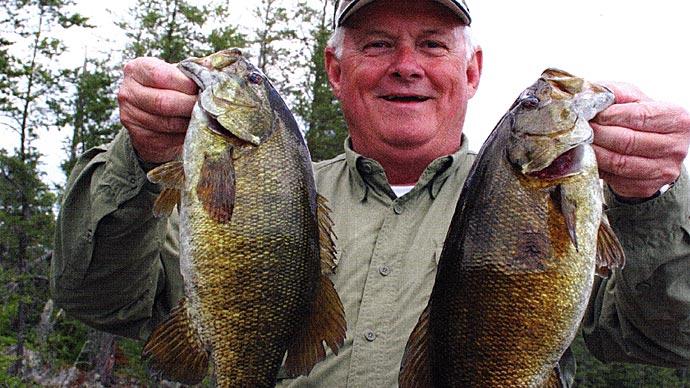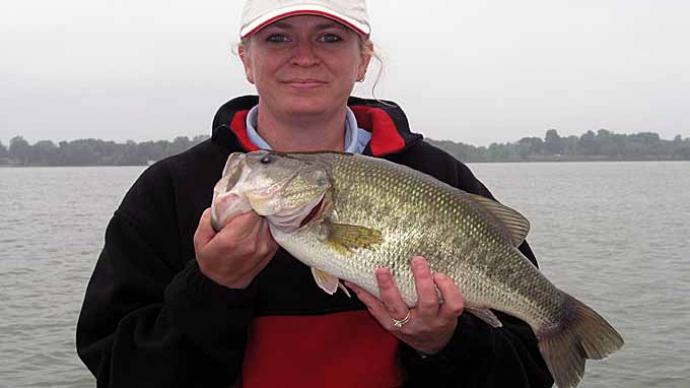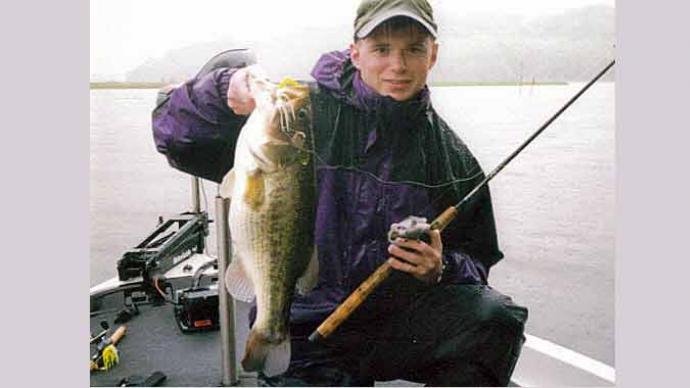
One of the advantages in working a booth at the annual Sportsmen's Shows is getting to meet other vendors and their representatives. As a pro staffer for the G. Loomis line of bass and walleye rods, I happened to meet a colleague who was an expert in salmon and steelhead fishing. "Bass, eh? I haven't had much time for short sleeve fishing!" Well, I broke out laughing immediately. Bass fishing has been referred to with various forms of slang, from "lip ripping" to "hog hunting", but "short sleeve fishing" was a new one on me!
Obviously, my fellow fisherman's impression of bass fishing consisted of hot summer days on lily pad filled lakes. Noticing a raised eyebrow when I mentioned that I fished for bass year round, I felt obliged to illustrate this startling revelation with a fishing story.
Several winters back I had been telling the manager of a local sporting goods store, how good the winter smallmouth fishing was on a nearby lake. We decided to take a day off and give it a try. As luck would have it, we awoke to find snow on the ground. To make matters more challenging, it was the third straight day of below freezing temperatures. His phone call was brief; "Are we still going?" I said; "Absolutely!"
Arriving at the launch ramp, we stepped from the truck to gaze upon a lake that was as smooth as glass. Correction; smooth as ice. The entire shore line was frozen. Unable to launch the boat, we decided to go to another lake about 30 minutes away. Being a larger body of water we figured it might not be frozen. We were right.
After launching our boat we started motoring up the ice cold lake. Where to start? Faced with colder water temperatures and a different body of water, I was not sure the same patterns and tactics I had been using on my local lake would work here on a lake miles away. But we had to begin somewhere, so we pulled up to a small point on the east side of the lake.
With chilled fingers we rigged 1/4 oz. jigs with Kalin's 4 inch finesse worms and began a slow controlled drift across the tip of the point. Reflecting on the previous week's experience, I suggested we start at depths of 25-30 feet. On our first pass both our rods arched as identical 2-1/2 lb. smallmouths came to the surface. Within an hour and a half we put 6 fish in the boat, the largest just over 3 1/2 pounds. Tempted to stay, we opted instead to see if this pattern would hold true on other parts of the lake.
After a short ride, we found ourselves over a sunken ridge. It appeared to run for a hundred yards or so, topping out at 25 feet. Within minutes another smallmouth surrendered to our pattern. During a pause in the action, I found myself reminiscing about a bass fishing clinic I had attended several years ago. "If you find yourself in a 'successful pattern' situation," suggested the speaker, "take advantage of it. Purposely deviate from the pattern, trying different lures, sizes, or presentations." The challenge was to see if an angler can isolate the specific factors contributing to their success.
I suspected the slow methodical retrieve we were using might be one of those keys, and this seemed like the perfect time to put it to the test. I told my partner to continue fishing the same pattern. I decided to try the more traditional style of hopping or swimming the bait back. The test resulted in the next three fish finding their way to the boat via my partner. My patient experimentation screeched to a halt. After all, there is only so much experimenting a guy can do when his partner is announcing, "I've got another one!"
Since then, I have spent many chilly but fruitful days fishing the same patterns and techniques on yet a third lake not too far away. There is, however, one major difference: the fish run a lot larger! New Year's Day found my partner and I launching the boat at the third lake while most of Western Washington's fishing population were still in bed recovering from the previous night's celebrations. Having positioned ourselves over one of the many small points in deeper water, we let our jigs settle to the bottom. Halfway through the telling of a tall fish tale, I am interrupted from down below. It's only 7:30 a.m., but I'm hooked up with a big one!
"Do you need a net?" my partner asks. Our first glance at the fish sends him scrambling for the net. Several rod bending surges later, a 5 lb. 4 oz. smallmouth finally surrenders to get his picture taken, and is then quickly released. It was to prove to be another great day of winter fishing. (Of the seven fish landed, only one of them went under 3 pounds!)
As I look back over the last ten years of winter fishing, several factors have consistently led to successful days on the water. Location, being number one. Look for points, large or small, as long as they are surrounded by deep water. If these points happen to have rock piles, old debris from past dumping, or just changes from hard to soft bottoms, these are key spots.
Lures
When it comes to baits, think down sizing. I prefer using Kalin's 4 inch finesse worms. My partner on the other hand likes to use 3 inch Kalin grubs. In both cases we use them on jigs in the 1/4 to 1/2 ounce size, depending on how deep or how windy the day proves to be. When purchasing jigs, look for either the mushroom or football head type. Both offer light wire hooks, which prove to be a huge advantage for a solid hook set.
Presentation
Once we find the fish the next trick is to get them to bite. As I have stated earlier, dragging your offering slowly along the bottom is far more productive then casting out and hopping or swimming your lure back. Both jigs and Carolina rigs seem to work equally well under these conditions.
Tackle
The key word here is going to be sensitivity. Remember, you are trying to detect pickups that are seldom more then the sensation of light pressure on your rod, but trust me: this is the time to set the hook! When selecting your rod, go with the most sensitive rod you can. My rods of choice are the G. Loomis GLX and IMX. The two rods I fish most are the SJR 722S - a six foot rod best suited for fishing jigs, and the PR 8400 SC - a seven foot rod ideal for Carolina rigs or split shot fishing.
Line
Above we have mentioned lures, rods, tactics, but what about line? In past years I have used a number of high quality low diameter monofilament lines with good success. Fellow anglers, those days are over. Berkley recently provided some of their new FIRE LINE for field testing. The results? Put the monofilament away! Skeptical at first, field testing has made a believer out of me! While this low diameter line comes in a variety of sizes, I prefer the 10 pound test with 4 pound diameter. This high strength - low diameter line provides two big advantages. First, it allows me to fish with lighter weights and still get to the bottom. Secondly, with ten pound strength I can apply more pressure to the fish before it has a chance to totally exhaust itself. Fireline's greatest advantage, however, is its low stretch - high sensitivity property. Most of the strikes you will receive during winter fishing with monofilament will feel like nothing more then a heavy sensation on your rod. But with FIRE LINE the strike feels more like the traditional 'thump.'
Given a chance, I'm confident that many of you armchair anglers will find there is more to winter bass fishing then watching it on television. Winter time bass enthusiasts usually have the lake to themselves. Consider joining us. It would be great to see you out on the water. You'll have no trouble recognizing us; we'll will be the ones wearing the short sleeve shirts. Granted, they will be hidden under a lot of winter clothing!




